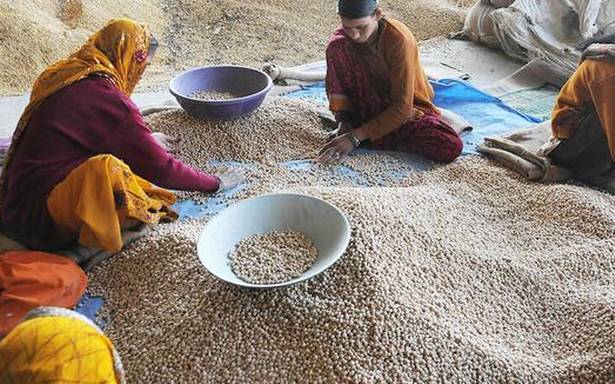The trade calls it a curious case of chana (chickpeas) during the year 2020. The prices oscillated between a wide range of ₹3,800 a quintal in March 2020 to ₹5,600 in October 2020 before falling to ₹4,375 on Tuesday.
During the year, chana prices shot-up by about 47 per cent within a span of six months to hit a peak. But it took barely two months to crash by close to 22 per cent from the peak to current levels.
Sharp swing
What triggered this sharp swing in chana prices? The trade puts the blame on speculative forces triggered by government’s free food scheme and opacity on stock positions that kept all participants in the dark about the actual demand and supply scenario.
“Chana’s movement during 2020 was very volatile. It is debatable what could have triggered this swing. The market corrected from the peak recently and some say demand has dried due to free distribution done by the government under its public distribution schemes. Secondly, a downward trend in futures market impacted the sentiment in the spot markets too,” Zhaverchand Bheda, Chairman of India Pulses and Grains Association (IPGA) told BusinessLine.
In its fourth advance estimate for 2019-20 crop, the government had projected gram (or chana) crop at 11.35 million tonnes – higher by about 1.4 million tonnes – a record in recent years. This caused a resistance to a bull run in chana. But Covid-19 induced purchases by government for subsidised /free food distribution unlocked massive government demand.
In October, analysts believed the the Government purchases of chana under the Centre’s Pradhan Mantri Garib Kalyan Anna Yojana (PMGKAY) fuelled the demand. The Government purchased chana through Central agency – Nafed – for the PMGKAY to distribute 1 kg of pulses per month per household covering 1.95 crore households which were financially impacted due to the Covid-19 lockdown.
What also pushed up the demand was the buying of chana as a substitute of imported yellow peas and kabuli chana, which attracted higher import duty.
Shortfall
As per trade estimates, the crop size for the year 2019-20 was estimated at 10 million tonnes. The Nafed purchases were pegged at 2.1 million tonnes apart from the substitution effect adding 1.5 million tonnes of chana demand. This left about 6.4 million tonnes to be supplied for local demand, which is usually projected at 8 million tonnes. This caused a shortfall of about 1.6 million tonnes and fuelled the price sentiment during October.
Also, not much of the floating stock – the stock available for trade with brokers – was available in the market. But the free food scheme ended in November 2020. This left to a huge quantity of about a million tonnes in Nafed godowns. the trade suspected the government would release this stock through an open tender ahead of the beginning of the new season in February 2021 causing a bearish sentiment in the market. This, accompanied by the higher sowing projections for chana in the current rabi sowing, pulled down the prices from the October peaks.
This article is auto-generated by Algorithm Source: www.thehindubusinessline.com


